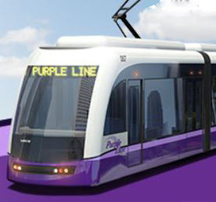Rework BRT Plan, Start Trial Run Now
We are greatly encouraged by the county's engagement with bus rapid transit over the last two years. This debate has been valuable in educating the public about the need for new transportation policies.
However, the plan sent by the Planning Board to the County Council is not acceptable in its current form because it does not offer people a good alternative to sitting in traffic and, in some important respects, will even make it harder to create bus lanes. We believe the Council should order an immediate trial run of BRT by dedicating existing lanes for buses on a major bus corridor with heavy traffic (such as Veirs Mill Road, US 29 in Four Corners, New Hampshire Avenue in Takoma Park, or Georgia Avenue near the Beltway). At the same time, it should return this plan to the Planning Board with the following instructions:
- Eliminate the concept that creation of bus lanes requires “acceptable” traffic conditions. The idea behind BRT is exactly the opposite — it's when roads are congested that dedicated bus lanes ensure that people will have an alternative to sitting in traffic.
- Repurpose more lanes as bus lanes and eliminate reversible median lanes.
- Develop a functional master plan amendment for a third MARC track.
The Planning Board draft of the Countywide Transit Corridors Functional Master Plan sets out an ambitious vision for the county's future. The board and its staff (thanks especially to Larry Cole, who led the staff effort) have moved BRT from an abstraction to a concrete, and well-chosen, network of corridors. But the best staff work cannot bear fruit unless matched with the right policy choices. Those policy choices are the responsibility of the Council.
The basic rationale for BRT is that giving buses priority enables them to move faster in areas where traffic is congested. Fifty years of experience demonstrates that widening highways and adding turn lanes does not get rid of traffic jams, it makes them worse. Transit cannot eliminate traffic jams either, but it can get people to their destinations quickly despite the traffic jams.
The proposed master plan has it exactly backwards when it says that existing lanes should not be turned into bus lanes unless the flow of car traffic will be “acceptable.” If traffic is moving at acceptable speed, buses can move as fast in the regular lanes as in bus lanes. It is where car traffic is slow that buses move faster in their own lanes. Requiring “acceptable” traffic conditions where bus lanes are created would keep bus lanes out of the places where they will do the most good. Decisions must be based on what will move the greatest number of people, not the most cars.
Thus the plan should include more repurposed lanes, especially on three corridors that the Institute for Transportation Development Policy says will be among the four most successful: Route 29, Georgia Avenue and Veirs Mill Road. These roads are already home to the county's most-used Metrobus routes. (BRT on Route 355, the fourth corridor identified by ITDP, should move forward in parallel, beginning with the median busway in White Flint which is already in the master plan.)
Lane repurposing costs far less than building new lanes. The full buildout of the proposed network will have to wait for funding behind other high-priority transit projects such as the Purple Line, the Red Line, and the MARC Growth and Investment Plan. Yet the least expensive segments of the network have high ridership potential. By repurposing lanes, we can start to create our BRT system now.
We especially prefer repurposed lanes in areas where the plan calls for single-lane, reversible medians. To our knowledge, this configuration of BRT has not been tried anywhere in the world. The reversible median lane will be confusing for transit riders because buses in each direction will alternate between using the median and the curb lane throughout the day. It will also require greater capital expenses to build new medians, it will require extra land for four platforms at each station, and it will be harder for pedestrians to cross the street.
Even less innovative BRT configurations will require some trial-and-error to adjust to our county's road network, which is more suburban in layout than other places where BRT has been tried in this country. Thus a trial run will provide valuable feedback for planning efforts. It will also provide immediate benefits to commuters, and be a demonstration of the value of BRT for the rest of the county.
Finally, we are disappointed that the Planning Board did not include a specific proposal for a third track for MARC. This important project, which will make possible all-day two-way commuter rail service, was supposed to be part of this plan along with BRT. The Planning Board should be instructed to move ahead immediately to develop a functional master plan for the MARC third track, so that right of way will be reserved in new developments at White Flint and elsewhere.
Sincerely,
Tina Slater
Action Committee for Transit, President

